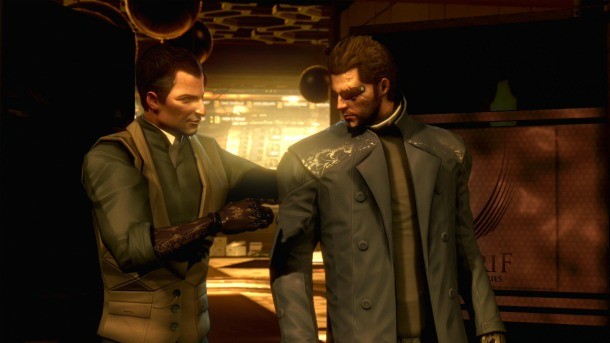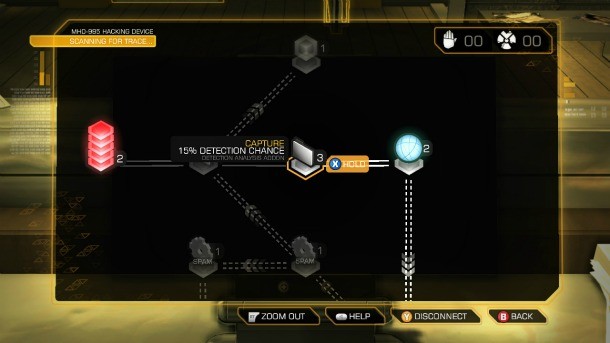Please support Game Informer. Print magazine subscriptions are less than $2 per issue
Deus Ex: Human Revolution Review

With Ion Storm dead and celebrated creators Warren Spector and Harvey
Smith each in new stages of their careers, developer Eidos Montreal
faces the difficult task of bringing back one of gaming’s most
celebrated series. Eidos sticks to Ion’s original vision, offering a
game that supports deep stealth, combat, exploration, and RPG-style
upgrade and conversation systems. Throughout most of this adventure, the
player is empowered with an authoritative role over the gameplay flow.
Depending on how a scenario is approached, individualized tactics can
produce varied results that impact the story, obtainable loot, and shape
of the world. An entire courtyard of civilians could end up dead, or
the only casualty could be a computer’s security system getting hacked.
Unfortunately, not all of these mechanics work as well as others, and
your enjoyment is tied to how heavily you lean on the more polished
portions.
In addition to the vast amounts of player
choice, Human Revolution weaves an amazing story filled with heady
techno-babble. In the year 2027 (25 years before the events in the first
game in the series), society is struggling with the ethics of
augmenting the human body with mechanical implants. The debate is at a
tipping point, and what happens next won’t be determined by the people
but rather the biotechnology companies and the corrupt governments that
back them. Players take the role of Adam Jensen, an ex-SWAT officer
turned security specialist for biotech company Sarif Industries, who
finds himself intertwined with the conspiracies. After a rival biotech
company injures him in an attack, he unwillingly receives augmentations,
putting him in a unique position to understand the costs and benefits
of the technology.
For most of my first of two complete playthroughs of Human Revolution I relied on stealth tactics to achieve my goals. Sneaking through rival office spaces and biotechnology labs is an exhilarating experience. A fantastic cover mechanic and unpredictable enemy behavior enhance this approach, but it requires patience. I often found myself hiding behind a crate to learn an enemy’s routine before engaging. Moving like a ghost gets the blood pumping, especially in heavily fortified areas loaded with patrols, turrets, and cameras. The reward isn’t just the satisfaction of getting through a zone undetected. Along the way, you can loot offices, hack computers, and uncover additional weapons, items, and story content. I loved how often I found myself debating if I should take a risk for a potential reward. Almost every environment dangles tasty carrots in front of the player; some are obtainable from the outset, others require backtracking once the player reaches higher ranks for hacking or strength. I still have several secret locations I want to return to scribbled in my notepad.

Exploring the cities is one of this game’s most rewarding
experiences. I know this doesn’t sound like an enthralling activity, but
the soaring architecture in each city produces multi-tiered exploration
across rooftops, into the backrooms of stores, through seedy alleys and
into heavily populated living quarters. The Blade Runner-esque
environments are packed with high-tech architecture and a sense of
despair hangs over the proceedings. Every character in the game, whether
it’s a bum digging through a trashcan or a security guard positioned on
a helipad, can be talked to. They may give a canned response, or they
may seek help and offer up a secondary mission to take on. Most of these
characters have interesting stories to tell, and many of the secrets
that are found provide extensive backstory for the world and its locals.
Jensen’s
personality mirrors that of The Matrix’s Neo. This guy radiates
boredom, but despite his monotone emotions, he’s a skilled
conversationalist capable of negotiating with terrorists and bending
people to his will. Just like Mass Effect, the player controls the tone
of these conversations. After hearing a pitch from his boss, Jensen can
respond with an intrigued, grudging, or callous thought. A hostage
situation brings up conversation threads for humbled, reasoned, and
empathetic approaches. These choices are not the only factors at play;
characters often reveal their true intentions through body language. The
conversation system is brilliantly devised, and all of the writing
within it is top notch. Even ridiculous character names like “Anonymous
X” are met with the appropriate levels of dry sarcasm from Jensen.
Although Jensen is outfitted in the latest and greatest that biotechnology has to offer, his arms run on cheap batteries – worse than the generic varieties packaged with TVs. Whenever Jensen performs a stealth takedown, he drains this battery. If he only has one active cell, which is usually the case, he can’t perform another takedown until the battery charges. That’s right: A character with state of the art metal arms can’t choke or punch an enemy without cell energy. He just has to stand behind them and wait for 30 to 40 seconds (upgrades can reduce the time). If the enemy turns, Jensen can enter his inventory to consume an energy bar – you read that correctly, he stops for a snack – to restore energy instantly. The ridiculousness of this concept is blatant. In the future, if your TV remote’s batteries die, try plugging carbohydrates into it.

Having multiple charged cells further breaks the stealth experience.
Since a stealth takedown transitions to an animation sequence that
freezes the action, Jensen can bounce from one enemy to the next with
little risk. A guard, standing no more than two feet away from a friend
Jensen is brutally stabbing, won’t do anything during the animation. He
just stands there until the animation concludes. By then, it’s too late –
I’ve already initiated a stealth takedown on him. If you can picture
dominoes getting stabbed and falling in a bloody mess, you have an idea
of how Human Revolution’s battery cells can break the experience.
Computer
hacking also suffers from balance issues. Once Jensen upgrades his
hacking stealth to level three (which can be achieved within a matter of
hours) he decreases the chance of detection by 45 percent and the
thrill of hacking is lost until you come across the level five security
rating terminals toward the end of the game. Hacking is a huge portion
of this game, used to break into all locked doors, safes, and computers.
Do yourself a favor and base your hacking upgrades on the progressive
increases in difficulty. Bypassing security systems can be a lot of fun
when it's balanced just right.

Upgrading Jensen’s augmentations opens up new gameplay options and,
as the hacking illustrates, overly effective advantages. Some of the
augmentations add new skills (like the ability to see through walls),
while others (like the ability to lift heavy objects) add to Jensen’s
exploration opportunities. Choose your augmentations wisely, as the
sheer number of options can shape Jensen in completely different ways
and potentially keep large sections of the game blocked off. I finished
every side mission I came across and spent hours exploring, and still
had 30 upgrades left to activate at the game’s conclusion. Sadly, no new
game plus option is offered.
When I was feeling up for a
challenge, I would engage in firefights. The guns are responsive and
work well with the smartly designed cover system, but when enemies are
alerted their intelligence is often stripped away. On rare occasions
they’ll rush Jensen’s location (which often is countered with a cheap
stealth kill). Most of the time, they’ll hunker into one cover location
and bob up and down to take shots. They often throw themselves directly
into harm’s way, and their lack of aggressiveness means Jensen can often
sit in one place to pick them all off. On the plus side, Jensen can’t
take too many hits. A few shots to the chest and he’ll be down and out.
Bullets are also hard to come by. While the gunplay is exploitable to a
degree, it does strike a nice balance with Jensen’s limited health and
ammo to create intense battles.
Combat is most disappointing in
the boss battles – horribly repetitious arena fights against
super-powered foes that can usually drop Jensen before he even knows
what hit him. My approach to these difficult conflicts was to get off to
a good start, save my game, then repeat this process until they were
defeated. In the last boss battle, I hid in a closet shelf until the
boss’ weakness was revealed – not exactly the epic showdown I was
expecting.
I know I take issue with many aspects of this game, but these flaws don’t hold Human Revolution back from being an entertaining adventure through a riveting story and world. It rewards those who fight through it with a fantastic plot payoff and a great sense of character progression. The problematic gunplay AI and annoying stealth takedown mechanics keep the game from greatness, but if played a certain way, Human Revolution captures the spirit of its predecessors and can be a blast. Even if it’s not a masterpiece, this entry lays the groundwork for a promising future for the series.











